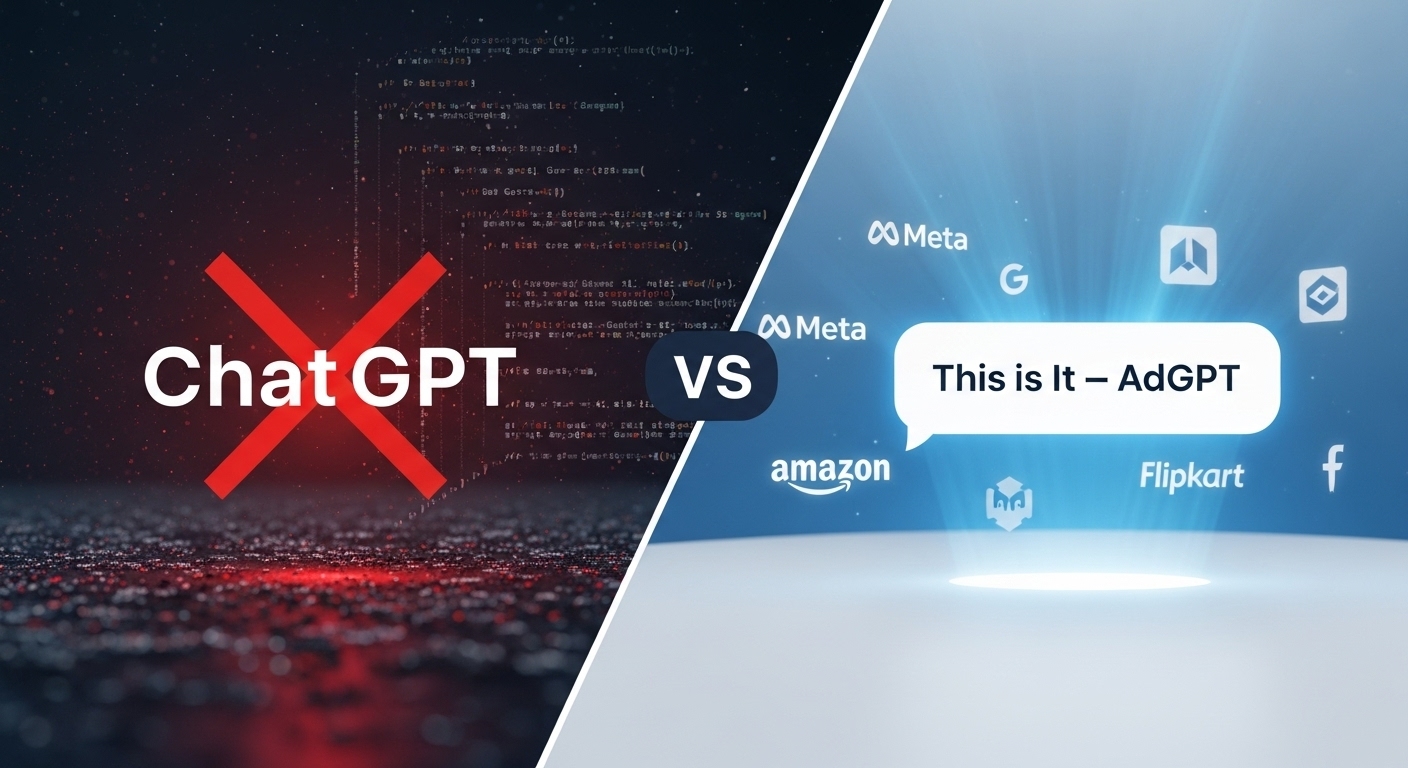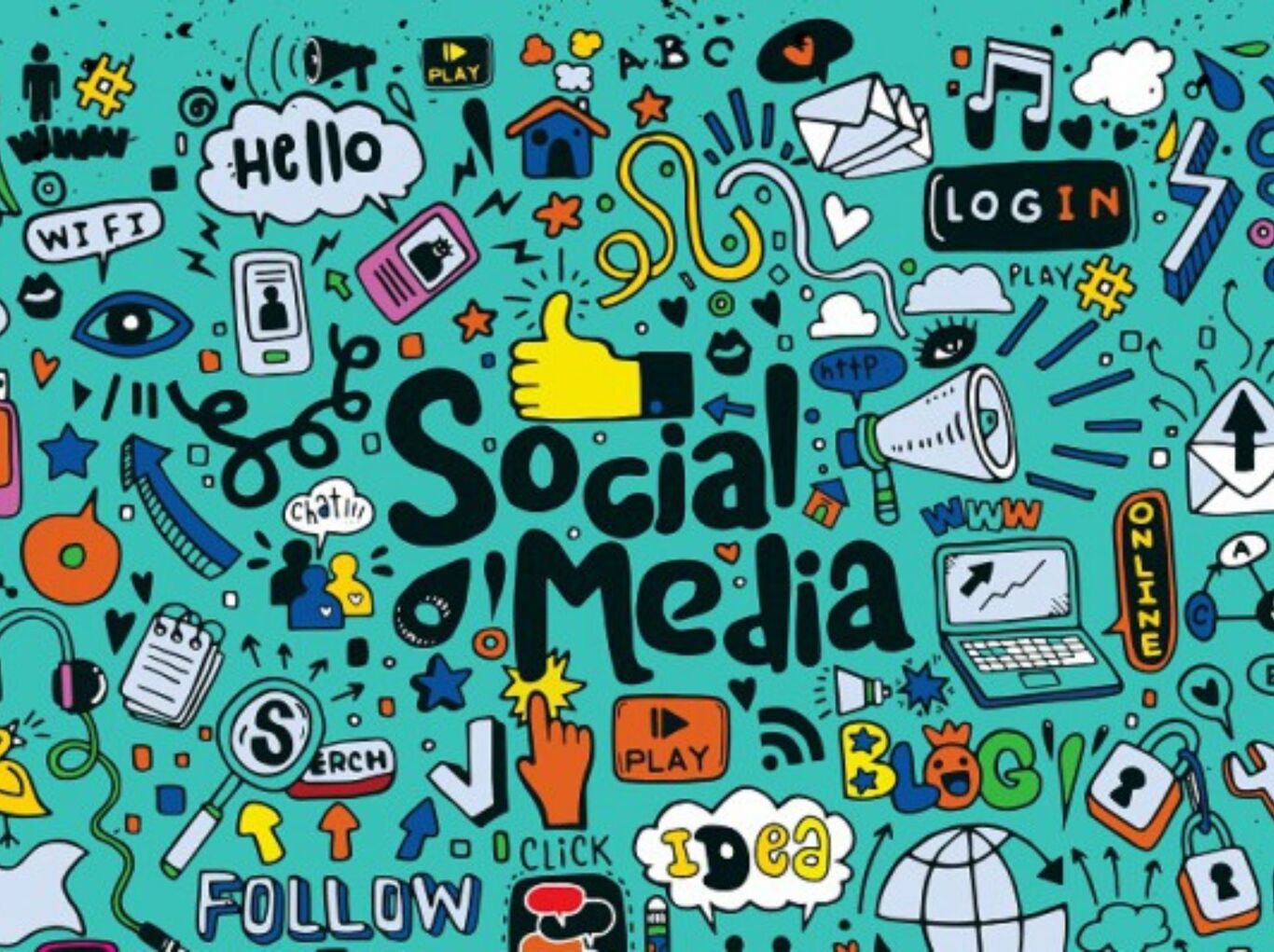Beyond ChatGPT: Why Intellsys AdGPT Leads in Conversational Marketing Intelligence

"ChatGPT is smart. But it's not enough."
This has become the rallying cry across enterprise marketing departments in 2025. Marketers have ChatGPT. They've asked hundreds of questions. They've written prompts at 11 PM. They've integrated it into workflows. And they've discovered the cold truth: a general-purpose conversational AI, no matter how powerful, cannot make marketing decisions.
The problem isn't ChatGPT's intelligence. The problem is its fundamental design. ChatGPT is built to be universally useful. Intellsys AdGPT is built to be specifically decisive. This distinction between conversation and prescription, between information and action defines the next generation of marketing AI.
The ChatGPT Paradox: Why General AI Falls Short for Marketing Decisions
What ChatGPT Actually Does (and Doesn't Do)
ChatGPT is a generative language model. Its job is to generate coherent, contextually appropriate text based on patterns in its training data. It excels at:
- Answering questions conversationally
- Generating creative content (copy, ideas, headlines)
- Explaining complex concepts in simple terms
- Writing and editing text-based materials
But ChatGPT has critical blind spots when it comes to operational marketing decisions:
1. No Real-Time Data Access
ChatGPT's knowledge was last updated with a training cutoff date. It cannot access live campaign data, real-time platform metrics, or current performance dashboards. Ask ChatGPT "Should I pause my Meta campaign today?" and you get a generic answer based on hypothetical principles, not your actual data.
By 2027, 90 million people will rely on AI search as their primary discovery tool. Yet ChatGPT cannot query live ad metrics across Google Ads, Meta, The Trade Desk, Amazon, Shopify, and 195+ other platforms. A marketing decision without real-time data is speculation, not strategy.
2. No Integration With Your Ad Stack
ChatGPT exists in isolation. It cannot:
- Connect to your CRM to understand customer lifetime value
- Query your ad accounts to see performance trends
- Access your customer data warehouse
- Pull real-time attribution data across channels
- Understand your specific business definitions (CAC, ROAS, LTV, MER)
This isolation is catastrophic for B2B and performance marketing. When a CFO asks "Which channel should get more budget?" ChatGPT gives a framework. Intellsys AdGPT gives a decision backed by your actual data.
A 2025 MIT study found that 95% of enterprise generative AI pilots fail. The core reason: "Generic tools like ChatGPT excel for individuals because of their flexibility, but they stall in enterprise use since they don't learn from or adapt to workflows". Without integration, AI advice remains advice it never becomes action.
3. Hallucinations and Factual Inaccuracy
ChatGPT is prone to hallucinations; confident-sounding statements that are completely false. In marketing contexts, this is dangerous. ChatGPT might claim that "conversions from paid search typically convert 40% better than organic leads" based on a pattern it learned, when your actual data shows the opposite.
This matters because hallucinations destroy trust. When a CMO runs one recommendation from ChatGPT and it fails because it was based on imaginary data confidence evaporates. Marketing decisions require accuracy, not eloquence.
4. No Prescriptive Logic, Only Descriptive Responses
ChatGPT answers questions. It does not prescribe actions tied to outcomes. There's a massive difference:
ChatGPT: "What should I do about my rising CPL?"
Response: "Rising CPL usually indicates increased competition, audience saturation, or creative fatigue. Consider expanding your audience, testing new creatives, or adjusting your bidding strategy. You might also audit your landing pages to improve conversion rates."
This is technically correct. It's also useless. It gives five possible directions with no prioritization, no impact projection, no timeline, and no clear move.
AdGPT: "What should I do about my rising CPL?"
Response: "Your CPL rose 30% due to audience overlap (58% of spends targeting overlapping segments). Priority one: Reduce audience duplication by 40% (projected 18% CPL reduction, 48-hour window). Priority two: Shift 20% budget to lookalike audiences (projected 8% reduction, 72-hour ramp). Expected combined impact: 24% CPL improvement within one week."
This is prescriptive. It's decision-ready.
The MIT Finding: Generic enterprise AI pilots fail 95% of the time, while purpose-built AI solutions from specialized vendors succeed 67% of the time. ChatGPT is a generic tool. AdGPT is purpose-built.
The Evolution From Chatbots to AI Agents to Prescriptive Intelligence
To understand why Intellsys AdGPT is different, it's helpful to understand where conversational AI stands in the broader AI landscape:
Level 1: Chatbots (Rule-Based)
- Follow predefined scripts
- Respond to recognized keywords
- Cannot learn or adapt
- Handle simple FAQs and basic questions
- Example: "What are your business hours?"
Level 2: AI Chatbots (Generative AI-Powered)
- Use natural language processing to understand intent
- Generate relevant responses based on patterns
- Can handle slightly more complex conversations
- Still limited to reactive, conversational interaction
- Example: ChatGPT answering marketing questions
Level 3: AI Agents (Agentic Intelligence)
- Proactively analyze data and suggest actions
- Can execute multi-step workflows autonomously
- Integrate with external systems and tools
- Learn from outcomes and adapt over time
- Example: AI sales agent that qualifies leads, sends follow-ups, and updates CRM
Level 4: Prescriptive AI Agents (Decision Intelligence)
- Everything Level 3 does, plus:
- Delivers specific, ranked recommendations tied to measurable outcomes
- Explains reasoning with business logic and data
- Integrates domain expertise (marketing playbooks, channel dynamics, customer economics)
- Updates recommendations in real-time as conditions change
- Example: Intellsys AdGPT
Most organizations using ChatGPT are stuck at Level 2: reactive conversation. They're asking questions and getting answers, but not getting decisions or actions.
Intellsys AdGPT operates at Level 4. It doesn't just answer questions. It prescribes moves, explains outcomes, integrates data, and drives execution.
The Critical Differences: ChatGPT vs. Intellsys AdGPT
| Dimension | ChatGPT | Intellsys AdGPT |
|---|---|---|
| Data Source | Training data (knowledge cutoff) | Real-time integrations (200+ platforms, hourly refresh) |
| Business Context | Generic principles | Your CAC, ROAS, LTV, customer cohorts, market conditions |
| Response Type | Conversational advice | Prescriptive recommendation + playbook |
| Outcome Focus | Information sharing | Decision + projected impact + confidence |
| System Integration | Isolated (no connections) | Deep (Google Ads, Meta, CDPs, CRMs, DWH, etc.) |
| Learning Mechanism | Static model | Learns from your outcomes and refines recommendations |
| Accuracy Requirement | Conversational fluency | Operational precision (95%+ accuracy required) |
| User Outcome | "I understand the situation better" | "I know exactly what to do and why" |
The Marketing Context: A B2B SaaS CMO needs to decide budget allocation across five channels. ChatGPT provides frameworks. AdGPT provides a ranked decision with CAC, LTV, and growth projections for each channel, specific to their customer base and market conditions.
Why Conversational Marketing Is Broken Without Prescriptive Intelligence
The Conversation-to-Decision Gap
When marketing moved from dashboards to conversational AI, it felt revolutionary. Suddenly, marketers could ask natural language questions instead of building reports. "What's my ROAS?" instead of "Navigate to Dashboard > Reporting > Metrics > ROAS."
But this was an illusion of progress. Ease of asking a question is not the same as ease of making a decision.
The gap exists because conversational AI (like ChatGPT) answers what you ask. It doesn't anticipate what you need, doesn't prioritize among options, and doesn't tie recommendations to outcomes. You still need to:
- Interpret the answer
- Validate it against your intuition
- Decide which recommendation to act on
- Estimate the impact
- Execute
- Monitor results
All of this work is still happening in the human brain. The AI didn't compress the decision cycle; it just changed the interface.
The Chatbot Ceiling
MIT research shows that chatbots hit a performance ceiling in enterprise environments. They excel at user-facing interactions (customer service, FAQ deflection) but stall when decision-making is required. Here's why:
Chatbots are reactive. They wait for you to ask a question. Prescriptive systems are proactive. They identify problems before you notice them.
Chatbots lack context. They don't know your business model, competitive position, or organizational constraints. AdGPT integrates all three.
Chatbots can't execute. They can suggest you adjust your bid strategy, but they can't connect to Google Ads and change it. AI agents can. Prescriptive AI agents do so only when impact projections support the change.
Chatbots don't learn from outcomes. They don't track whether their recommendations were right or wrong. Prescriptive systems learn and improve with each decision cycle.
Intellsys AdGPT: What Prescriptive Intelligence Actually Does
Prescriptive analytics moves beyond descriptive ("What happened?") and predictive ("What will happen?") to answer the decisive question: "What should we do?" and "What will happen if we do it?".
In marketing, prescriptive intelligence means:
- Unified Data across all your advertising channels
- Real-time Analysis of performance, trends, and opportunities
- Ranked Recommendations prioritized by business impact
- Outcome Projections tied to your specific metrics (CAC, ROAS, LTV, growth)
- Playbooks with step-by-step execution logic
- Integration with your existing systems to enable action
Intellsys AdGPT delivers all six.
The Three Operational Promises
Promise 1: Clarity Through Unified Data
ChatGPT cannot connect to your ad accounts. Intellsys AdGPT connects to 200+ integrations Google Ads, Meta, Amazon, The Trade Desk, Shopify, Salesforce, HubSpot, custom data warehouses, and more.
This unified data creates one truth across your organization. When your CFO asks "Are we hitting our CAC target?" the answer isn't debated it's factual, backed by real-time data, visible to all stakeholders.
No more circular meetings about data definitions. No more conflicts between what Sales thinks is CAC vs. what Finance calculates vs. what the analytics team reports. One conversation. One truth.
Promise 2: Decisions Translated Into Action
ChatGPT answers your question. AdGPT prescribes your next three moves, explains the reasoning, projects the impact, and integrates with your systems to enable execution.
When CPL rises, ChatGPT tells you why it might be rising. AdGPT tells you exactly why (with data), what to do (with step-by-step instructions), and when (with timeline and confidence).
This isn't incremental. This compresses decision cycles from days to minutes.
Promise 3: Continuous Learning and Improvement
ChatGPT is static. It doesn't improve based on your results. AdGPT learns. Each recommendation that works informs the next. Each outcome that diverges from projection updates the model.
Over quarters, this compounds. Better recommendations → Better execution → More data → Better recommendations. This is how prescriptive intelligence creates lasting competitive advantage.
The Real Cost of Staying With ChatGPT
Organizations using ChatGPT for marketing intelligence are incurring massive hidden costs:
1. Decision Latency
Compressing a decision from 3 days to 15 minutes across 5-10 major decisions per quarter is 200+ hours of freed leadership time. Over a year, that's 5 people. ChatGPT hasn't freed that time it's still trapped in interpretation and validation.
2. Execution Friction
ChatGPT recommends you "adjust your audience targeting." You then must navigate to each platform, manually update targeting, and hope your interpretation of the recommendation matches the original intent. Prescriptive systems with API integrations reduce manual work by 60-70%.
3. Missed Opportunities
ChatGPT reacts to your questions. Real-time prescriptive intelligence proactively alerts you to opportunities. A sudden drop in ROAS on a top channel? AdGPT flags it before you notice. A pricing opportunity based on competitor data? AdGPT surfaces it in your next brief.
4. Compounding Suboptimization
Each decision made with generic advice instead of prescriptive recommendations creates a 5-15% efficiency loss. Over a year, with 50+ marketing decisions, that's 250-750% in cumulative opportunity cost.
The Trust Issue
95% of enterprise generative AI pilots fail, according to MIT. The core reason: lack of trust in the recommendations.
ChatGPT can "hallucinate" generate confident-sounding but false statements. When a CFO tests a ChatGPT recommendation and it underperforms because it was based on incorrect assumptions, confidence in all future AI recommendations collapses.
Prescriptive systems solve this through explainability and outcome tracking. Every recommendation includes visible reasoning. Every outcome is tracked. Over time, trust builds because recommendations consistently deliver results.
How Prescriptive Intelligence Redefines Conversational Marketing
Intellsys AdGPT keeps the ease of conversation you speak naturally, in English but backs it with prescriptive logic and real-time data analytics.
Example Conversation:
Marketer: "Our CAC is up 25% in the last two weeks. Why?"
AdGPT: "Analysis across 147 campaigns and 8 channels identified the root cause: Your top-performing lookalike audience (3M people, $40 CAC) was expanded to 12M people. The new audience segment (9M people) has a 65% lower conversion rate (projected $52 CAC). Recommendation: Pause expansion, revert to 3M audience, test alternative expansion in lower-saturation segments."
Marketer: "What's the impact if I do this?"
AdGPT: "Reverting expansion reduces immediate spend by $15K/day but improves CAC back to $40 within 48 hours. Testing alternative segments: 72-hour ramp, potential 18% volume growth at improved CAC. Combined impact: +$45K weekly incremental profit by month-end."
Marketer: "Do it."
AdGPT: "Executing now. Pausing expanded audience (2 minutes), reverting to baseline (5 minutes), scheduling alternative segment test to launch tomorrow 9 AM. All changes logged and auditable. Will alert you at the 48-hour mark with preliminary results."
This is prescriptive intelligence in practice. Conversation. Real-time data. Ranked recommendation. Projected outcome. Integrated execution. Transparency.
ChatGPT cannot do this. Not today. Not without fundamental architectural redesign.
Why 2025 Is the Inflection Year for Prescriptive Marketing Intelligence
Three factors have converged to make prescriptive marketing intelligence inevitable in 2025:
1. Generative AI is Mature Enough to be Reliable
Generative AI models in 2024-2025 are stable, accurate, and production-ready. The novelty phase is over. This frees up mental bandwidth to focus on purpose-built applications instead of general-purpose experiments.
2. Marketing Data Is Dense and Integration-Ready
The modern marketing stack is API-native. 200+ platforms have open integrations. Data warehouses can ingest and centralize metrics across all channels. Real-time data pipelines are commodity infrastructure.
3. Decision Velocity Has Become the Competitive Edge
Ad platforms (Google, Meta, Amazon) now update algorithms hourly. Customer behavior shifts daily. Market windows close in minutes. Companies that make marketing decisions in 2-3 days are competing with companies that decide in 15 minutes. Speed has become existential.
All three conditions are true, right now, in late 2025. This is why prescriptive intelligence adoption is accelerating.
The Shift in How Marketers Think About AI
The ChatGPT moment created novelty. "Wow, I can ask an AI to write a copy!" But novelty wears off. The question becomes: "Can this AI make me money?"
ChatGPT makes you smarter. Prescriptive intelligence makes you faster and more profitable. These are different categories. One is a tool; the other is a platform that reshapes how decisions are made.
Companies that adopt prescriptive intelligence first will outcompete those relying on general-purpose chatbots. Not because the chatbot is bad, but because it's designed to do something different.
The Competitive Moat: Why Prescriptive Intelligence Compounds
Decision Velocity × Learning × Compounding
Organizations that move to prescriptive intelligence gain a structural advantage that widens over time:
More Decisions Per Quarter (3x faster cycle time) → More Experiments → More Data → Better Recommendations → Faster Decisions
This creates a flywheel effect. Companies running at algorithmic speed accumulate competitive advantages that become nearly impossible to overcome.
Example: Company A uses ChatGPT (decisions take 2-3 days). Company B uses prescriptive AI (decisions take 15 minutes).
In one quarter:
- Company A makes ~40 major marketing decisions
- Company B makes ~120 major marketing decisions (3x more)
Over a year:
- Company A accumulates 40 × 4 = 160 decisions
- Company B accumulates 120 × 4 = 480 decisions
3x more learning. 3x more data. 3x more optimization. By year 2, the gap is insurmountable.
Talent Gravity
High-performing marketers prefer working in organizations where decisions are data-driven, transparent, and fast. Prescriptive intelligence attracts better talent and accelerates their productivity.
Over time, this compounds: Better tools → Better talent → Better decisions → Better results → Better tools.
ChatGPT-powered organizations don't attract the same caliber of talent because execution still feels manual and slow. Prescriptive intelligence attracts teams that want to work at algorithmic speed.
Addressing the ChatGPT Advocates: But What About...?
"ChatGPT Has Real-Time Search Now"
Yes, ChatGPT now has real-time search capability. But real-time web search is not the same as real-time integration with your ad accounts.
ChatGPT can search the web for information about "latest marketing trends." It cannot query your specific Meta ad account and see that Audience Segment #5 has a 40% drop in CTR since 3 AM this morning.
The difference: ChatGPT has information access. AdGPT has operational access.
"We Can Prompt Engineer Our Way to Better Results With ChatGPT"
Prompt engineering improves ChatGPT's outputs within its design constraints. It doesn't fundamentally change those constraints. You can write perfect prompts all day; ChatGPT still can't execute actions, integrate with your ad accounts, or learn from your outcomes.
It's like optimizing a typewriter to write faster. The tool has fundamental limits.
"Can't We Just Add Integrations to ChatGPT?"
Some integration solutions exist (e.g., Singular's ChatGPT MCP integration), but they're shallow. They let ChatGPT query your data but don't fundamentally change its architecture it still generates conversational responses, not prescriptive recommendations tied to outcomes.
Real prescriptive intelligence requires a different system design, not just integrations bolted onto a general-purpose model.
The Path Forward: Adopting Prescriptive Intelligence
Adopting prescriptive marketing intelligence requires three prerequisites:
1. Clear Data Integration
Your ad accounts, CRM, CDP, DWH, and analytics platforms must be connected and clean. Data quality is non-negotiable. Bad data in = Bad recommendations out.
2. Agreed-Upon Business Metrics
Your organization must have consensus on how CAC, ROAS, LTV, and MER are calculated. If different teams define metrics differently, recommendations will confuse rather than clarify.
3. Commitment to Action
Prescriptive intelligence is only valuable if recommendations are executed. Organizations that treat AI recommendations as "interesting insights to consider" will see no ROI. Those that implement recommendations systematically will see 25-40% efficiency improvements.
The Adoption Curve
Organizations that adopt prescriptive intelligence typically see results in phases:
- Month 1-2: Quick wins with simple recommendations (pause underperforming campaigns, reallocate small budgets)
- Month 3-4: Deeper engagement, more complex questions, growing trust
- Month 5-6: Behavioral shift, team defaults to prescriptive guidance
- Month 6+: Compounding recommendation quality improves, outcomes accelerate
Successful adopters report 25-40% improvement in marketing efficiency, 30-50% faster optimization cycles, and 15-25% better overall ROI by month 9.
Conclusion: ChatGPT is Not Enough. AdGPT Is.
ChatGPT was the inflection point. It proved that conversational AI could be powerful, accessible, and useful at scale. Every marketer now understands AI's potential.
But ChatGPT's very generality is its limitation. It's designed to be useful for everything, which means it's optimized for nothing. It's a flashlight in a dark room. Useful. But not enough to navigate the room safely.
Intellsys AdGPT is a laser. Focused. Prescriptive. Integrated. Outcome-driven. It doesn't replace conversational AI; it transcends it.
The organizations winning in 2025 aren't those with the best ChatGPT prompts. They're those running at algorithmic speed making three times more decisions, testing three times more variations, learning three times faster.
ChatGPT is good for learning. Prescriptive intelligence is good for winning.
For marketing teams ready to move beyond conversation to decision, beyond advice to action, beyond novelty to competitive advantage, the era of prescriptive marketing intelligence is here.
Key Takeaways
- ChatGPT is conversational AI, not prescriptive AI it answers questions but doesn't prescribe ranked, outcome-tied decisions
- 95% of enterprise AI pilots fail because generic tools lack context and integration purpose-built solutions succeed 67% of the time
- Prescriptive intelligence integrates real-time data, business logic, and automated execution ChatGPT does none of these
- Decision velocity is now the competitive edge organizations making decisions 3x faster accumulate 3x more learning
- The inflection is happening now 2025 is when prescriptive marketing intelligence shifts from novel to necessary
- Adoption compounds over time early movers gain structural advantages that widen with each quarter








